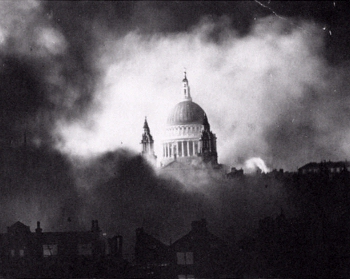Children were evacuated to the countryside, some even overseas to North America. The majority of Londoners, however, chose to remain in the city, including the Royal Family, who helped to boost the general morale immensely. Londoners soon grew accustomed to a new routine. When night fell each evening, they would draw their blinds. Streetlights would remain off. Traffic in the city became a hazard to both motorists and pedestrians due to poor visibility. Some families would sequester themselves in Anderson shelters assembled in their backyards. Some individuals would wear gas masks in anticipation of an attack. Some families headed underground to the Tube stations to find protection. Many Londoners (60%) simply remained in their homes, maybe with a frying pan over their head. Some brave souls grew bored and climbed up on rooftops and balconies to witness the attack first hand. According to war correspondent Ernie Pyle:
"You have all seen big fires, but I doubt if you have ever seen the whole horizon of a city lined with great fires -- scores of them, perhaps hundreds...These things all went together to make the most hateful, most beautiful single scene I have ever known." *
The next morning, Londoners had to make their way through the rubble as they headed for work or for school. Some returned from the underground stations to find their house flattened. Some houses survived the bombings but remained uninhabitable. There is the story of one woman who found a German plane in her garden, complete with the pilot trying to make an exit; she turned him in to the local authorities.
Although Hitler aimed to demoralize Londoners to the point that Britain would surrender in 1940, the Blitz actually united the British in a common cause. The Nazis' plans for Operation Sea Lion, a land invasion of Britain, were shelved by mid-1941 in favour of an attack on the Soviet Union. And Londoners got their city back.
*"The London Blitz, 1940", EyeWitness to History, www.eyewitnesstohistory.com (2001).
Note: Read cartoonist Ben Wicks' book, Nell's War: Remembering the Blitz, drawing on first hand accounts of the London Blitz.

Photograph of St. Paul's Cathedral, which remained intact during the Blitz, courtesy of http://cache2.artprintimages.com
No comments:
Post a Comment